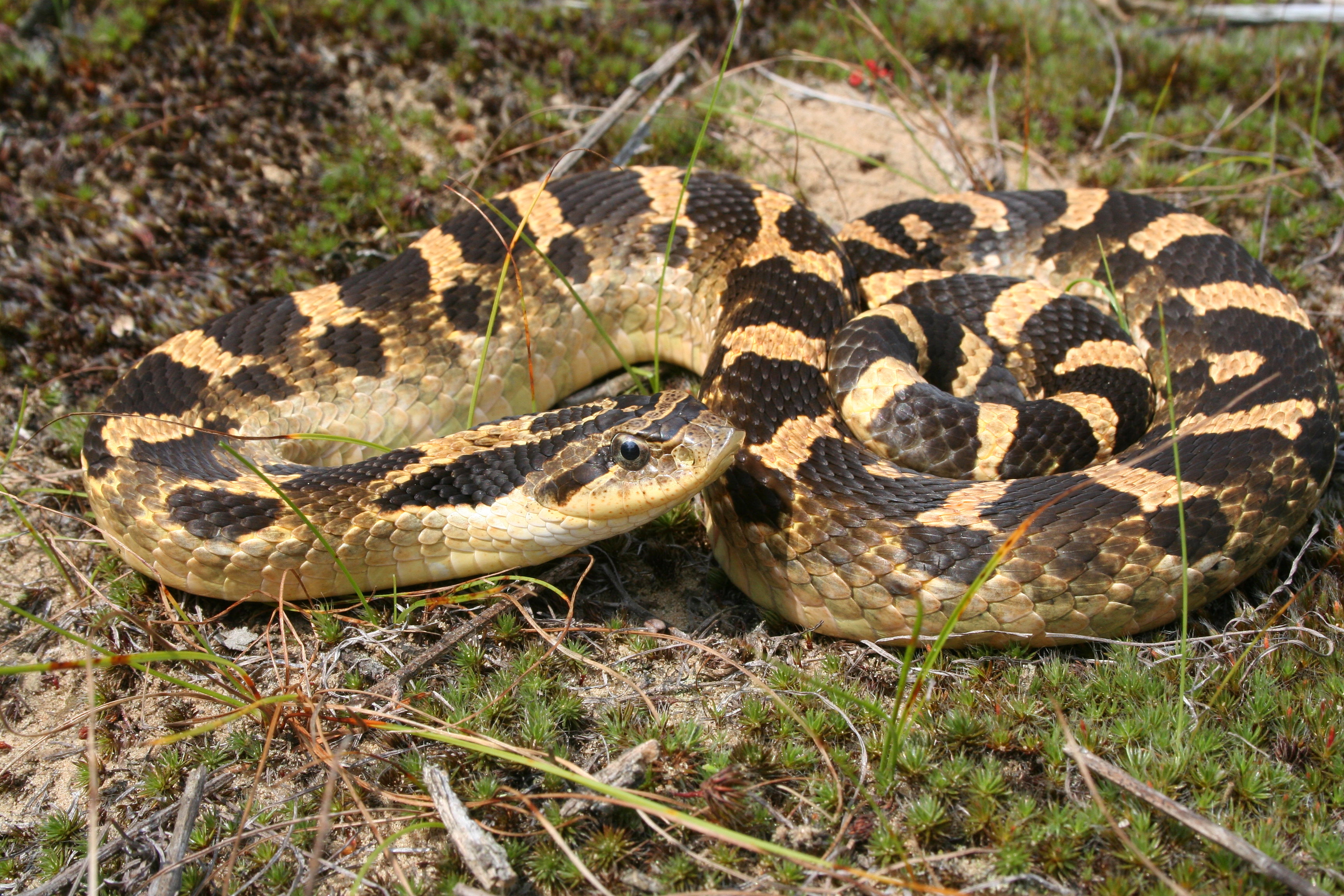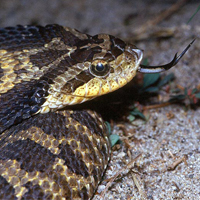Eastern Hog-nosed Snake

Species information
This chapter provides a review of progress towards the protection and recovery of Eastern Hog-nosed Snake in Ontario from 2007 to 2016.
Eastern Hog-nosed Snake (Heterodon platirhinos) is a thick-bodied snake with a distinctive ridged scale on the tip of its snout. The species has rear fangs and very weak venom that help to subdue its prey, but is not dangerous to humans. Although it can grow up to a length of one metre, adults are typically 50 to 85 centimetres in length. Colouring and patterns are highly variable among individuals. Some have very distinct patterns with dark blotches, while others have faint or no blotches and are predominantly solid gray, brown or olive in colour. The species is usually found only in areas where its preferred prey species, American Toad (Bufo americanus) and Fowler’s Toad (Bufo fowleri), are present. It is known for elaborate defensive behaviour when threatened, raising its head, flattening its neck and hissing loudly, but rarely bites. If the threat persists, it may writhe, flip onto its back and play dead.
The Eastern Hog-nosed Snake is found in eastern North America as far north as Minnesota, west to Kansas, and south to Florida and the Gulf coast. In Ontario, it is found in two distinct geographic areas: within the Carolinian Region of southwestern Ontario, where it occurs in a few isolated locations, and in the Great Lakes/St. Lawrence Region of central Ontario, where it is broadly distributed. The species typically occurs in areas with sandy soils, which it requires for nesting, but individuals use a wide range of habitats throughout the rest of the active season, including forests, beaches, dunes, old fields, rock outcrops, forest clearings and edges, and shorelines.
Eastern Hog-nosed Snake faces several threats to its survival and recovery including habitat loss, degradation and fragmentation, road mortality, persecution, illegal collection and contaminants in the environment. The high mobility of this species increases the likelihood of adverse impacts from habitat fragmentation, particularly due to road mortality.
The survival and recovery of Eastern Hog-nosed Snake are influenced by other factors as well. A decline in toad populations could also present a threat to the species’ survival over time.
Eastern Hog-nosed Snake is listed as threatened at both the provincial (Species at Risk in Ontario List) and federal (Schedule 1 under the Species at Risk Act) levels. Globally, it is considered to be secure (NatureServe).
Provincial status
Prior to the Endangered Species Act, 2007 (ESA or “the Act”) the Committee on the Status of Species at Risk in Ontario (COSSARO) assessed Eastern Hog-nosed Snake as threatened. Following this assessment, it was listed on the Species at Risk in Ontario list as threatened in 2004 and retained its threatened status when the ESA came into force in 2008. In future assessments, COSSARO may consider information gained through protection and recovery actions regarding the species’ threats and trends in population and distribution.
Species and habitat protection
Protecting the Eastern Hog-nosed Snake and its habitat are key components in the implementation of the ESA, and continue to be government-led actions, as identified in the government response statement. As a threatened species, Eastern Hog-nosed Snake has been protected from being killed, harmed, harassed, captured or taken under the ESA since it came into force in 2008. In addition, the species’ habitat has been protected from being damaged or destroyed since June 30, 2013. Eastern Hog-nosed Snake also receives general protection as a Specially Protected Reptile under Schedule 9 of the Fish and Wildlife Conservation Act, 1997 (FWCA). The ESA does not require a habitat regulation to be developed for transition
Any person who negatively impacts Eastern Hog-nosed Snake or its habitat without prior authorization may be prosecuted under the ESA.
Eastern Hog-nosed Snake has been protected from being killed, harmed, harassed, captured or taken since 2008.
In addition, the habitat of Eastern Hog-nosed Snake has been protected from being damaged or destroyed since since June 30, 2013, based on the general habitat definition in the ESA.
Recovery strategy
A recovery strategy for Eastern Hog-nosed Snake was published on December 7, 2011, which was in advance of the timeframe required by the ESA. Recovery strategies are advice to government and represent the best available scientific knowledge. The strategy identifies the habitat needs of Eastern Hog-nosed Snake and the threats that it faces, while recommending objectives and approaches for protecting and recovering the species. The recovery strategy also includes recommendations on the areas of habitat to be considered in the development of a habitat regulation.
Government response statement
The Ministry of Natural Resources and Forestry (“the Ministry”) published the government response statement (GRS) for Eastern Hog-nosed Snake on September 7, 2012, which was within the timeframe required by the ESA. The GRS is government policy that contains the Government of Ontario’s goal for the recovery of Eastern Hog-nosed Snake.
To help achieve this goal, the government leads and supports recovery actions identified in the GRS. Common actions for the government to lead as it works towards achieving a species’ recovery goal are provided in Section 2.5 of the Species at Risk Program Status (2008-2015). A specific action for the government to lead to help protect and recover Eastern Hog-nosed Snake is:
Recovery Goal
The government’s goal for the recovery of Eastern Hog-nosed Snake is to maintain current population levels of Eastern Hog-nosed Snake, and where possible, increase connectivity of existing populations and ensure the natural expansion of their range.
- Develop a survey protocol to be used by proponents and partners to detect the presence or absence of Eastern Hog-nosed Snake.
The GRS for Eastern Hog-nosed Snake also lists seven actions the Ministry supports others to undertake for the species. These government-supported actions fall under the objectives identified in the GRS, which are:
- Reduce identified threats and increase habitat connectivity for Eastern Hog-nosed Snake;
- Increase knowledge of presence, distribution and abundance of Eastern Hog-nosed Snake in Ontario;
- Improve knowledge of Eastern Hog-nosed Snake habitat, population viability and prey; and
- Raise awareness and promote stewardship of Eastern Hog-nosed Snake in Ontario.
Government-funded projects
An important government-led action in the GRS for Eastern Hog-nosed Snake is to support partners to undertake activities to protect and recover the species. Through the Species at Risk Stewardship Program, the Ministry has supported a total of 105 projects designed to contribute to the protection and recovery of Eastern Hog-nosed Snake.
In addition to the funding provided through the Species at Risk Stewardship Program, partners focusing exclusively on Eastern Hog-nosed Snake reported they were successful in securing $61,855 in additional funding and in-kind support from other sources, as did partners with projects designed to benefit multiple species at risk, including Eastern Hog-nosed Snake ($7,101,289).These amounts include additional funding and in-kind support in the form of time and expertise provided by volunteers.
Stewardship partners reported that provincial funding helped them to secure in-kind support by involving 18 individuals who volunteered 320 hours of their time toward protection and recovery activities that focused exclusively on Eastern Hog-nosed Snake, which has an estimated value of $7,600. As well, a total of 34,371 individuals volunteered 80,708 hours of their time toward protection and recovery activities for multiple species at risk, including Eastern Hog-nosed Snake, which has an estimated value of $1,739,461.
Stewardship partners reported that, through both their efforts and the efforts of their volunteers to implement actions contained in the GRS, they were successful in enhancing 2,786 hectares of habitat that will benefit multiple species at risk, including Eastern Hog-nosed Snake. In addition, stewardship partners reported providing focused outreach on Eastern Hog-nosed Snake to 2,500 individuals, as well as ecosystem-based outreach on multiple species, including Eastern Hog-nosed Snake, to 1,603,388 individuals.
The remainder of this section highlights four projects supported through the Species at Risk Stewardship Program as well as the corresponding government-supported recovery actions for the species.
Stewardship work carried out by the Georgian Bay Biosphere Reserve (GBBR) since 2008 has collectively addressed multiple GRS actions to support the protection and recovery of Eastern Hog-nosed Snake. In 2011, GBBR developed a best management practice document for public works activities that could assist in protecting multiple species at risk and their habitats. The document describes the peak movement/nesting period for Eastern Hog-nosed Snake, how to mitigate impacts, and includes periods of least risk for carrying out various public works activities. In 2014, GBBR surveyed select roads in the Georgian Bay area to determine road mortality hotspots and installed species at risk road crossing signs. During surveys, multiple snake species at risk were observed, including Eastern Hog-nosed Snake.
In addition, targeted outreach work conducted by GBBR since 2008 has encouraged townships in the Georgian Bay area, individuals and various organizations to implement best management practices (BMPs) for protecting snake habitat. GBBR has conducted multiple workshops for public works and planning staff from four townships. These workshops have trained over 200 participants on BMPs to promote knowledge of snakes and their habitat, how to consider species at risk in their daily work, and how to record sightings of species at risk. Significant outreach work has also targeted members of the public, First Nations and Métis communities and organizations, hunters and anglers, nature clubs, schools and other organizations to encourage implementation of these practices. The outreach opportunities have allowed GBBR staff to promote awareness of local species at risk, their habitat requirements and threats, and encouraged members of the public to get involved in stewardship activities. The significant stewardship work carried out by GBBR has addressed the GRS actions to assess and mitigate threats, identify and mitigate traffic mortality locations, and increase awareness.
The Long Point Basin Land Trust has led an eight-year project to conserve Carolinian reptiles in the Long Point Basin. The project consists of reptile surveys and population monitoring, a public reptile reporting and information program, outreach and awareness, and creating and monitoring Carolinian reptile habitat. The objectives in 2014-2015 were to reduce human-induced mortality, create and monitor enhanced habitat, implement and expand surveys, document current and historic records, raise awareness about reptiles, and engage landowners in site-specific recovery efforts. This is a good example of a long-term, community-focused project that has increasingly gained momentum with the public as they become directly involved in reptile reporting, habitat creation and monitoring. The project has also benefited from partnerships with several conservation groups, agencies and business partners. Partners have worked together to erect and monitor wildlife barriers along roads, target outreach to key groups to increase awareness and reduce threats, and develop a local reporting and survey program to inform planning for mitigation efforts and habitat creation sites. This multi-year, multi-species project has addressed several GRS actions including the high priority actions to assess and mitigate threats to Eastern Hog-nosed Snake habitat, and identify sites to reduce road mortalities with measures such as signage, ecopassages and fencing. The survey and reporting activity provides information that can contribute to development and implementation of a standardized population monitoring, inventory and reporting program.
In 2015, the Eastern Hog-nosed Snake Stewardship Cooperative and Riverstone Environmental Solutions received funding for a three-year project to investigate changes that have occurred in the Wasaga Beach population of Eastern Hog-nosed Snake since an earlier study from 2001 to 2005. Researchers conducted daily surveys in Wasaga Beach, including road mortality surveys. Individual snakes were implanted with radio transmitters to document their movements, behaviour, and habitat use. Physical characteristics such as sex, age and size were also recorded. This information will be used to understand the population health compared to historical data and monitor changes in population size, structure, and habitat use. Part of this project also included public education and outreach efforts such as engaging park users, presenting at community events, local elementary schools, and mailing out cards that included Eastern Hog-nosed Snake information to neighbourhoods around the park to encourage the reporting of observations. Public response to the mail-outs resulted in the identification of two new snakes, one of which was fitted with a transmitter, demonstrating that the significant outreach efforts contributed to the collection of valuable information about Eastern Hog-nosed Snake. Preliminary results from two of three years of research addressed multiple GRS actions, including: monitor and record species and population information using standardized survey methods, determine population trends and persistence, and increase awareness of the species to reduce persecution and promote its protection and recovery.
Ontario Nature has received funding from the Species at Risk Stewardship Fund since 2009 in order to develop and promote the use of the Ontario Reptile and Amphibian Atlas (ORAA), a tool for reporting and recording sightings of reptiles and amphibians in Ontario. The ORAA program conducts extensive outreach campaigns to educate the public about reptile and amphibian conservation and to encourage local stewardship activities. Outreach activities are focused on educating residents of Ontario on the diversity of reptiles and amphibian species that exist in Ontario, threats these species face, the value they provide and opportunities to contribute to stewardship efforts. The ORAA has collected 40,000 observations of species at risk, of which 630 are Eastern Hog-nosed Snakes. These data have resulted in updating the known range for this species. This key reporting tool has significantly increased our knowledge of Eastern Hog-nosed Snake as well as other species at risk reptiles and amphibians and supports the high priority GRS action to develop and implement a standardized population monitoring, inventory and reporting program. In 2014 alone, the program received over 25,104 new observations of reptiles and amphibians to be entered into the atlas and conducted six bio-blitzes involving over 670 individuals across Ontario.
Species at Risk Stewardship Fund
-
 $120,218
$120,218for Eastern Hog-nosed Snake exclusively
-
 $4,428,435
$4,428,435for multi-species projects that included Eastern Hog-nosed Snake
-
 $7,101,289
$7,101,289in additional funding and in-kind support
-
 105
105projects included the Eastern Hog-nosed Snake
-
 34,371
34,371volunteers
-
 80,708
80,708volunteer hours
-
 1,603,388
1,603,388people received outreach
-
 2,786
2,786hectares of habitat enhanced
Efforts to minimize adverse effects on and create an overall benefit for Eastern Hog-nosed Snake
Supporting partners to undertake activities to protect and recover Eastern Hog-nosed Snake, such as through permits and their associated conditions, is an important government-led action identified in the GRS for the species.
A total of 26 permits have been issued for Eastern Hog-nosed Snake since the species has been protected under the ESA: 21 ‘protection or recovery permits’ (i.e., 17(2)(b) permit) and five ‘overall benefit permits’ (i.e., 17(2)(c) permit).
‘Protection or recovery permits’ are issued if the purpose of the activity is to assist in the protection or recovery of a species at risk. Of the 21 ‘protection or recovery permits’ issued for the species, one was issued exclusively for Eastern Hog-nosed Snake and 20 were issued for multiple species. These permits enabled a variety of organizations to undertake activities such as conducting surveys for Eastern Hog-nosed Snake, evaluating the effectiveness of measures to mitigate adverse impacts to reptiles along roadways or highways, and conducting research on snake habitat use.
Five multi-species overall benefit permits have been issued that included Eastern Hog-nosed Snake. Several of the conditions attached to these permits are designed to implement government-supported actions identified in the GRS for Eastern Hog-nosed Snake, including:
- Creating artificial nesting and shedding sites and conducting effectiveness monitoring;
- Restoring and protecting habitat through a conservation easement or another mechanism to secure the habitat for long-term protection; and
- Developing educational pamphlets to be distributed to new and existing property owners and providing best management practices for living near species at risk habitat.
Other conditions designed to minimize adverse effects included, but are not limited to:
- Applying timing restrictions to the proposed activities to protect species during periods of the year when they are most sensitive;
- Installing and maintaining temporary exclusion fencing around construction areas; and
- Designing and installing educational signs to promote awareness and protection of the Eastern Hog-nosed Snake.
Further information regarding ‘overall benefit permits’ is available through Ontario’s Environmental Registry.
A total of 33 agreements were entered into for Eastern Hog-nosed Snake. These agreements were enabled through Ontario Regulation 242/08 (prior to the July 1, 2013 amendment). Conditions of the agreements involve implementing actions in the mitigation plans, including:
- Minimizing adverse effects (e.g., identifying sensitive time periods for the species and completing specific activities outside of these times);
- Outlining measures to address incidental encounters to protect individuals, nests, and juveniles; and
- Providing training for on-site workers on handling species at risk and to raise awareness of species at risk.
Sixty-four activities that may affect Eastern Hog-nosed Snake or its habitat have been registered for the purposes of Ontario Regulation 242/08 under the ESA. Eleven activities were registered under ‘Species protection, recovery activities’ (section 23.17), 41 under ‘Threats to health and safety, not imminent’ (section 23.18), eight under ‘Pits and quarries’ (section 23.14), three under ‘Newly listed and transition species’ (section 23.13), and one activity under ‘Drainage works’ (section 23.9). These registrations require the registered individual to comply with all conditions of the regulation, such as:
- Taking steps to avoid the activity during the times of year when the species is likely to be carrying out a life process related to hibernation or reproduction, including rearing;
- Ensuring that any person carrying out any part of the activity receives training on how to identify the species and its habitat, potential threats to the species and its habitat by the activity, and the steps that must be taken to minimize any adverse effects; and
- Reporting observations of the species to the Ministry.
-
21protection or recovery permits
-
5overall benefit permits
-
33agreements
-
64registrations
Guides and resources for Eastern Hog-nosed Snake
The Species at Risk Online Guides and Resources Toolbox is an electronic library of best management practices (BMPs) and technical resources to assist proponents and practitioners in meeting the requirements of the ESA and its regulations.
Road mortality is a significant threat to Eastern Hog-nosed Snake and reducing it is a primary objective in the GRS for the species. In 2013, the Ministry developed guidance on ‘Reptile and Amphibian Exclusion Fencing: Best Practices’ for use by landowners, conservation practitioners and environmental consultants to reduce the threats that roadways and associated roadwork pose to amphibians and reptile species at risk and their habitat. Building on this guidance, in 2016 the Ministry developed ‘Best Management Practices for Mitigating the Effects of Roads on Amphibian and Reptile Species at Risk in Ontario’. This BMP incorporates topics such as the impacts of roads and bridges on reptiles, considerations for avoiding and mitigating impacts, building wildlife crossing structures, monitoring the effectiveness of mitigation actions, and measures to influence both wildlife and driver behaviours. This document supports the high priority GRS action to identify sites where traffic mortality occurs and, where feasible, implement appropriate mitigation measures.
Developing a survey protocol to be used by proponents and partners to detect the presence or absence of Eastern Hog-nosed Snake is included in the GRS as a government-led action. In 2016, the Ministry released the ‘Survey Protocol for Ontario’s Species at Risk Snakes’. This document provides reliable, science-based survey methods for Ontario’s snake species, including Eastern Hog-nosed Snake, and is available upon request at your local MNRF district office. The protocol provides information on survey methodology, such as performing a records review, understanding the importance of environmental conditions when surveying, identification of survey sites, survey techniques, timing and search effort. A recommended survey form is included for documenting survey information and all observations of Eastern Hog-nosed Snake.
Occurrences of Eastern Hog-nosed Snake in Ontario
Natural Heritage Information Centre (NHIC)
Sixty-seven populations
Since 2008, the Ministry’s central repository at the Natural Heritage Information Centre (NHIC) has received over 3,400 records of the species. These records are based on observations between 1858 and 2016 and come from a variety of sources. Records submitted have helped to redefine where the species is known and has been known to occur and have provided additional information on the species’ habitat and threats. For example, more than 1,500 observations (several as recent as 2016) have been submitted for the Georgian Bay to Kawartha Highlands population. These additional records have confirmed that several smaller populations in this region should be considered as a single population.
Observations submitted to the NHIC have reconfirmed the existence of 19 extant populations and have also identified nine new extant populations. In addition, four populations that were previously considered historical are now considered extant. In contrast, eight populations which were previously considered to be extant are now considered historical as a result of the date that the species was last observed. A change from extant to historical reflects our knowledge of the population and may not be indicative of a change to the population. Five populations that were previously considered historical are now considered extirpated. Recent data submissions have also identified two historical and one extirpated population which were not previously known to the provincial database.
It is possible that there are observations of Eastern Hog-nosed Snake that have not been submitted to the Ministry. Encouraging the submission of observations of Eastern Hog-nosed Snake to the Ministry is included in the GRS as a government-led action. Submissions of species observations to the Ministry increases our knowledge of where they occur and can play an important role in assessing the viability of species populations.
Everyone is encouraged, or may be required by an authorization or approval, to submit observations of the Eastern Hog-nosed Snake, as well as any other species at risk observed, to the Natural Heritage Information Centre for incorporation into the provincial record of observations.
3,400 observations of the species were submitted to the NHIC since 2008
Summary of progress towards meeting the recovery goal
Summary of progress
Progress has been made toward all of the government-led actions and a majority of the government-supported actions outlined in the GRS for Eastern Hog-nosed Snake. The Government of Ontario has directly undertaken actions to:
- Develop a survey protocol to be used by proponents and partners to detect the presence or absence of Eastern Hog-nosed Snake;
- Educate other agencies and authorities involved in planning and environmental assessment processes on the protection requirements under the ESA;
- Encourage the submission of Eastern Hog-nosed Snake data to the Ministry’s central repository at the Natural Heritage Information Centre or the Ontario Reptile and Amphibian Atlas;
- Undertake communications and outreach to increase public awareness of species at risk in Ontario;
- Protect the Eastern Hog-nosed Snake through the ESA. Apply and implement habitat protection provisions of the Act by June 30, 2013;
- Support conservation, agency, municipal and industry partners and Indigenous communities to undertake activities to protect and recover the Eastern Hog-nosed. Support will be provided where appropriate through funding, agreements, permits (including conditions) and advisory services; and
- Establish and communicate annual priority actions for government support in order to encourage collaboration and reduce duplication of efforts.
Government-supported actions are organized under overarching recovery objectives. Progress has been made toward all of the government-supported recovery objectives and a majority of the associated actions that are identified in the GRS for Eastern Hog-nosed Snake.
Under the objective to reduce identified threats and increase habitat connectivity, considerable progress has been made towards two actions:
- Assess specific threats to Eastern Hog-nosed Snake habitat and mitigate those threats where appropriate (e.g., co-operate with existing landscape restoration activities to strategically implement habitat restoration measures for the species to maintain connectivity of habitat types) (Action No. 1; High Priority).
- Identify sites where traffic mortality occurs and, where feasible, implement appropriate mitigation measures which may include (Action No. 2; High Priority):
- A public outreach campaign aimed at driver education;
- Construction of ecopassages and installation of snake fencing along relevant roadways; and
- Temporary road closures where necessary.
These actions have been implemented through several projects supported by the Species at Risk Stewardship Program and through conditions of ESA authorizations. Numerous projects have focused on threat assessment and mitigation, habitat creation and restoration, and the assessment and mitigation of road mortalities. For example, a major park road in Rondeau Provincial Park was temporarily closed to reduce the threat of road mortality to the Eastern Hog-nosed Snake. In the Long Point area, ecopassages were constructed to improve habitat connectivity for the species.
Under the objective to increase knowledge of presence, distribution and abundance of Eastern Hog-nosed Snake in Ontario, considerable progress has been made towards the fourth action:
- Develop and implement a standardized population monitoring, inventory and reporting program which may (Action No. 4; High Priority):
- Monitor populations to identify and track changes in population abundance over time;
- Identify locations of hibernacula and other habitat features; and
- Complete surveys in conjunction with other species at risk, where appropriate, to determine the presence and distribution of Eastern Hog-nosed Snake.
Considerable progress toward this action has largely been implemented through the multi-year Ontario Reptile and Amphibian Atlas (ORAA) project supported by the Species at Risk Stewardship Program. The ORAA is a key reporting tool that has led to a significant increase in our knowledge of the distribution of Eastern Hog-nosed Snake and other at-risk reptile and amphibian species. The action has also been supported by several projects carried out by the Georgian Bay Biosphere Reserve, Long Point Basin Land Trust and Riverstone Environmental Solutions to monitor, inventory and report on species at risk reptiles, including Eastern Hog-nosed Snake and its habitat.
Under the objective to improve knowledge of Eastern Hog-nosed Snake habitat, population viability and prey, initial progress has been made towards the following action:
- Undertake research at representative sites across the species’ range to determine habitat use of adults and juveniles, home range size and population abundance (Action No. 5).
Initial progress toward Action No. 5 has been implemented through a project funded by the Species at Risk Stewardship Program by Riverstone Environmental Solutions; they conducted surveys and studied movement and habitat use of Eastern Hog-nosed Snakes.
Under the objective to raise awareness and promote stewardship of Eastern Hog-nosed Snake in Ontario, considerable progress has been made on the following action:
- Develop and provide information to enforcement officers, landowners, those working on the land, First Nations and Métis communities and organizations, municipal planners, and the pet trade to increase awareness, reduce persecution, and promote the protection and recovery of Eastern Hog-nosed Snake. Where appropriate, coordinate efforts with other snake at-risk awareness initiatives (Action No. 8).
This action has been implemented through numerous stewardship initiatives funded by the Species at Risk Stewardship Program. Reptile species at risk information materials, best management practices for municipalities, species specific targeted mail-outs and public presentations are a few examples of the significant outreach and education work that has been done for reptile species at risk, including Eastern Hog-nosed Snake, at provincial, regional and local scales.
The recovery goal for the species is to maintain current population levels of Eastern Hog-nosed Snake, and where possible, increase connectivity of existing populations and ensure the natural expansion of their range. Significant effort made toward the government-led and government-supported GRS actions has helped to make progress towards this goal. In addition, observations submitted to the NHIC for Eastern Hog-nosed Snake confirm the species’ continuing presence with 19 extant local populations verified, nine newly-identified populations and four historical populations that are now considered extant. The substantial number of observations for the area between Parry Sound and Kawartha Highlands Provincial Park has significantly increased our knowledge of the species distribution in this area.
While progress has been made toward maintaining the current distribution of the species, more long-term monitoring data is required to assess progress toward the goal of maintaining its population levels. In addition, five historical populations are now considered extirpated and further survey effort is required at historical sites to determine if they are still extant.
Increasing connectivity of existing populations and ensuring natural expansion of their range is important for the achievement of the GRS recovery goal. Effort has been made to restore habitat connectivity for species at risk through habitat restoration efforts such as the construction of ecopassages in the Long Point area. Further information on habitat connectivity efforts is also required to determine the progress towards this aspect of the Eastern Hog-nosed Snake recovery goal.
Recommendations
As stated in the GRS, the review of progress towards protecting and recovering Eastern Hog-nosed Snake can be used to help identify whether adjustments are needed to achieve the protection and recovery of the species. Based on progress to-date, the overall direction provided in the GRS for Eastern Hog-nosed Snake should continue to guide protection and recovery actions for the species, particularly for those actions identified as high priority in the GRS. Relative to actions that have received a high level of support, the following actions have received support to a lesser degree and may be considered in future decisions regarding the protection and recovery of the species:
Actions for which progress has been limited should be supported in future implementation planning, such as:
- Action No. 3: as opportunities arise, support the securement of habitat that contains Eastern Hog-nosed Snake populations through existing land securement and stewardship programs;
- Action No. 6: use basic life history data to estimate the effect of differing population sizes on the likelihood of the population surviving; and
- Action No. 7: determine Eastern Hog-nosed Snake dependence on toad populations for survival and investigate the food preferences of juveniles.
Although initial progress has been made towards the action to undertake research at representative sites across the species’ range to determine habitat use of adults and juveniles, home range sizes and population abundance (Action No. 5), further work is required to fully implement this action.
Moving forward, protecting and recovering Eastern Hog-nosed Snake will continue to be a shared responsibility that will require the involvement of many individuals, organizations and communities. Financial support for the implementation of actions may be available through the Species at Risk Stewardship Program. The Ministry can also advise if a proposed project may result in adverse impacts to the species or its habitat and, if impacts cannot be avoided whether an authorization may be required. By working together, progress can continue to be made towards protecting and recovering Eastern Hog-nosed Snake in Ontario.
Summary of progress toward the protection and recovery of Eastern Hog-nosed Snake (2007 to 2016)
Provincial status
Eastern Hog-nosed Snake is classified as threatened under the Endangered Species Act, 2007 (ESA). Prior to its transition to the ESA, Eastern Hog-nosed Snake was listed as threatened on the Species at Risk in Ontario List. The species has been protected from being killed, harmed, harassed, captured or taken under the ESA since 2008, and its habitat has been protected from damage or destruction under the ESA since 2013.
Species-specific documents and guidance published by the government
- Recovery strategy for Eastern Hog-nosed Snake (2011)
- Eastern Hog-nosed Snake: Ontario Government Response Statement (2012)
Government-supported stewardship projects
- Through the Species at Risk Stewardship Program, the Ministry of Natural Resources and Forestry (“the Ministry”) has enabled its stewardship partners to conduct a total of 105 projects that have supported the protection and recovery of Eastern Hog-nosed Snake. Three projects ($120,218) focused exclusively on Eastern Hog-nosed Snake, while the other 102 projects ($4,428,435) focused on multiple species at risk, including Eastern Hog-nosed Snake.
- The Ministry’s support helped its stewardship partners to involve 34,371 individuals who volunteered 80,708 hours of their time toward protection and recovery activities for species at risk, including Eastern Hog-nosed Snake. The estimated value of these voluntary contributions, as well as additional funding and in-kind support, is $7,101,289.
- Stewardship partners reported that through their actions 2,786 hectares of habitat were enhanced for Eastern Hog-nosed Snake and other species at risk that inhabit the same ecosystem.
- Stewardship partners reported providing outreach on multiple species at risk, including Eastern Hog-nosed Snake, to 1,603,388 individuals.
Supporting human activities while ensuring appropriate support for species recovery
- The Ministry of Natural Resources and Forestry (“the Ministry”) has issued 26 permits for this species: 21 ‘protection or recovery permits’ were issued under clause 17(2)(b), and five ‘overall benefit permits’ were issued under clause 17(2)(c) of the ESA.
- A total of 33 agreements were entered into for Eastern Hog-nosed Snake. These agreements were enabled through Ontario Regulation 242/08 (prior to the July 1, 2013 amendments).
- Sixty-four activities have been registered for the species. The activities were registered under “Species protection, recovery activities’ (section 23.17), ‘Threats to health and safety, not imminent’ (section 23.18), ‘Pits and quarries’ (section 23.14), ‘Newly listed and transition species’ (section 23.13), and ‘Drainage works’ (section 23.9) under Ontario Regulation 242/08 of the ESA.
Occurrences and distribution
Sixty-seven populations of Eastern Hog-nosed Snake have been documented in Ontario. Most of the populations are scattered in southwestern, and central Ontario, while one population is distributed across an area from Parry Sound to Kawartha Highlands Provincial Park. Currently, 32 of these populations are extant, 19 are considered historical, and 16 are considered extirpated. Since 2008, the status of eight populations changed from extant to historical based on the last observed date; and five populations that were previously considered historical are now considered extirpated. Recent observations submitted to the NHIC have reconfirmed 19 extant populations and also identified nine new populations. In addition, four populations that were previously considered historical are now considered extant.
Related information
- Categorizing and Protecting Habitat under the Endangered Species Act
- Natural Heritage Information Centre
- Ontario’s Endangered Species Act
- Ontario’s Endangered Species Act Regulation 242/08
- Ontario Recovery Strategy and Government Response Statement for Eastern Hog-nosed Snake
- Policy Guidance on Harm and Harass under the Endangered Species Act
- Species at Risk in Ontario List
- Species at Risk Stewardship Program
References
Robson, L.E. and Blouin-Demers, G. 2013. Eastern Hognose Snakes ( Heterodon platirhinos) avoid crossing paved roads but not unpaved roads. Copeia. 3:507-511.
COSEWIC. 2007. COSEWIC assessment and update status report on the Eastern Hognosed Snake Heterodon platirhinos in Canada. Committee on the Status of Endangered Wildlife in Canada. Ottawa. viii + 36 pp. (www.sararegistry.ca/status/status_e.cfm).
Footnotes
- footnote[1] Back to paragraph A transition species, for the purposes of this report, is an endangered or threatened species listed under schedule 1, 3, or 4 of the ESA that has not changed in status since June 2008.
- footnote[i] Back to paragraph A population is defined as an area of land and/or water on/in which an element (e.g., Eastern Hog-nosed Snake) is or was present. They are comprised of one or more observations and the area has a practical conservation value as it is important to the conservation of the species. An element occurrence is the technical term used to describe this.
- footnote[ii] Back to paragraph A population is considered historical if it has not been recorded within the last 20 years. Historical populations may still exist, but updated information is not available.